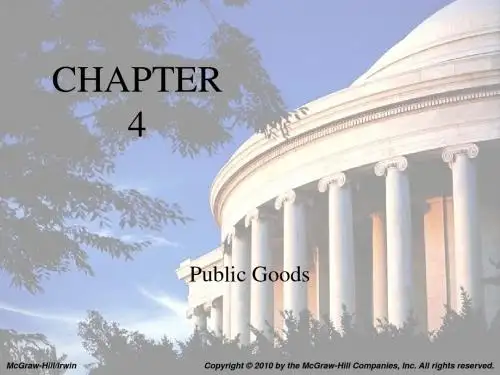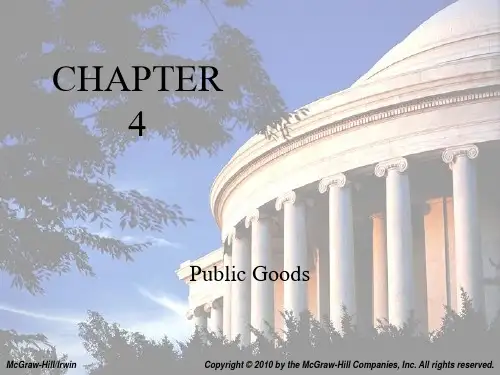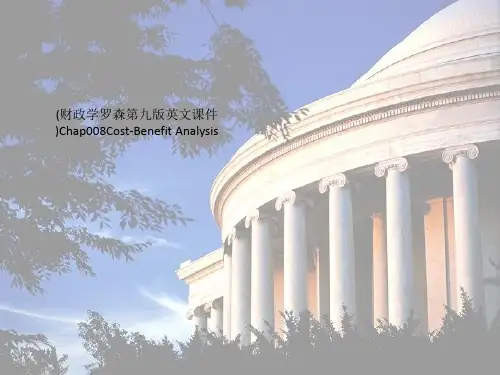罗森财政学课件chap16
- 格式:ppt
- 大小:1.04 MB
- 文档页数:49
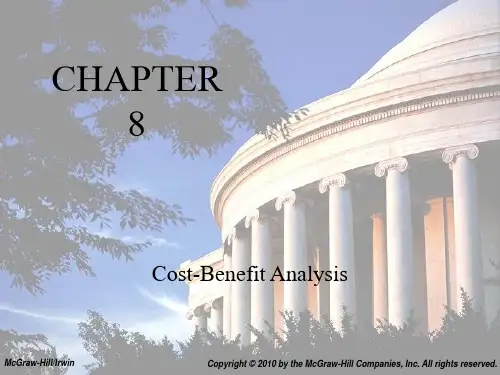

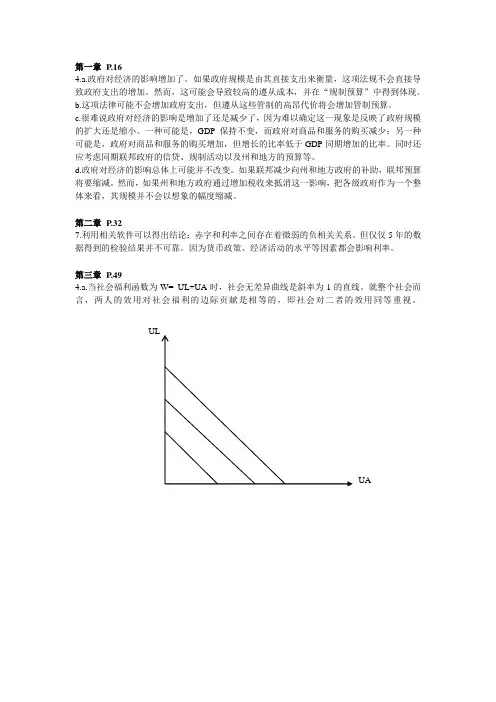
第一章P.164.a.政府对经济的影响增加了。
如果政府规模是由其直接支出来衡量,这项法规不会直接导致政府支出的增加。
然而,这可能会导致较高的遵从成本,并在“规制预算”中得到体现。
b.这项法律可能不会增加政府支出,但遵从这些管制的高昂代价将会增加管制预算。
c.很难说政府对经济的影响是增加了还是减少了,因为难以确定这一现象是反映了政府规模的扩大还是缩小。
一种可能是,GDP保持不变,而政府对商品和服务的购买减少;另一种可能是,政府对商品和服务的购买增加,但增长的比率低于GDP同期增加的比率。
同时还应考虑同期联邦政府的信贷、规制活动以及州和地方的预算等。
d.政府对经济的影响总体上可能并不改变。
如果联邦减少向州和地方政府的补助,联邦预算将要缩减。
然而,如果州和地方政府通过增加税收来抵消这一影响,把各级政府作为一个整体来看,其规模并不会以想象的幅度缩减。
第二章P.327.利用相关软件可以得出结论:赤字和利率之间存在着微弱的负相关关系。
但仅仅5年的数据得到的检验结果并不可靠。
因为货币政策、经济活动的水平等因素都会影响利率。
第三章P.494.a.当社会福利函数为W= UL+UA时,社会无差异曲线是斜率为-1的直线。
就整个社会而言,两人的效用对社会福利的边际贡献是相等的,即社会对二者的效用同等重视。
b. 当社会福利函数为W= UL+2UA时,社会无差异曲线是斜率为-2的直线。
这表明,与利维亚相比,社会两倍重视于奥古斯塔斯的效用。
c.结合效用可能性边界与社会无差异曲线,该种社会福利函数下的两种可能的最优解如下图所示。
ULUL8.当马克的收入的边际效用等于朱迪收入的边际效用时,社会福利最大化。
对已知条件中的两个效用函数求一阶导数,使MU M=MU J,则最大化条件为I J=4I M,因为固定收入是300美元,这意味着马克应该有60美元,朱迪应该有240美元,此时社会福利达到最大化。
10.a.错误。
帕累托效率的必要条件是,两种商品的边际替代率要等于其边际转换率。
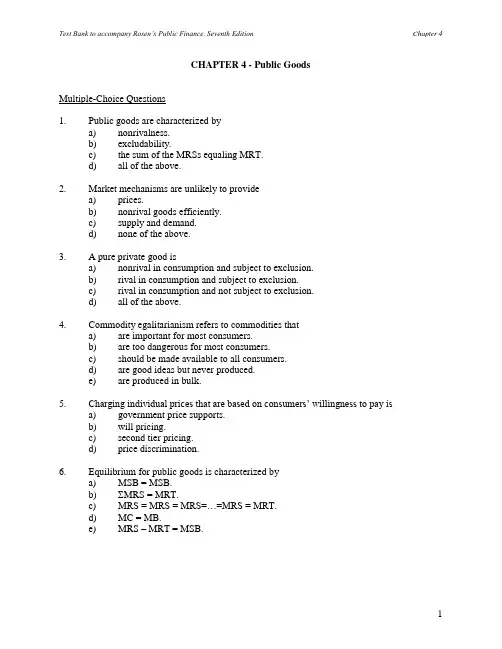
CHAPTER 4 - Public GoodsMultiple-Choice Questions1. Public goods are characterized bya) nonrivalness.b) excludability.c) the sum of the MRSs equaling MRT.d) all of the above.2. Market mechanisms are unlikely to providea) prices.b) nonrival goods efficiently.c) supply and demand.d) none of the above.3. A pure private good isa) nonrival in consumption and subject to exclusion.b) rival in consumption and subject to exclusion.c) rival in consumption and not subject to exclusion.d) all of the above.4. Commodity egalitarianism refers to commodities thata) are important for most consumers.b) are too dangerous for most consumers.c) should be made available to all consumers.d) are good ideas but never produced.e) are produced in bulk.5. Charging individual prices that are based on consumers’ willingness to pay isa) government price supports.b) will pricing.c) second tier pricing.d) price discrimination.6. Equilibrium for public goods is characterized bya) MSB = MSB.b) MRS = MRT.c) MRS = MRS = MRS=…=MRS = MRT.d) MC = MB.e) MRS – MRT = MSB.7. Summing demand curves horizontally sends market ______________ to individuals,while summing vertically sends market ______________ to individuals.a) price; priceb) quantity; quantityc) quantity; priced) price; quantity8. Public goods can bea) provided privately.b) provided publicly.c) subject to free rider problems.d) all of the above.9. A ________ is a person who wants to enjoy the benefits of a public good withoutcontributing his or her marginal benefit to the cost of financing the amount made.a) free riderb) politicianc) price makerd) price optimizer10. Congestible public goodsa) are nonrival in consumption.b) can not be priced in the market.c) are rival in consumption.d) are never provided by the private sector.11. A private good isa) nonrival in consumption.b) subject to free rider problems.c) subject to exclusion.d) not subject to exclusion.e) none of the above.12. When those that do not contribute to the costs of a public good are denied use, this is acase ofa) exclusion.b) being nonrival.c) price discrimination.d) infeasibility.e) all of the above.13. Which of the following is a public good?a) public defenseb) public televisionc) a libraryd) schoolse) all of the above14. Pure private goods are supplied througha) the market.b) government taxes.c) merit pricing.d) none of the above.15. School vouchers area) provided by the government.b) provided by private organizations.c) public funds to be used for private tuition.d) all of the above.Discussion Questions1. Suppose there are two individuals with identical demand curves characterized by theequation Q = (33/2) – (P/2). What is market demand if these demand curves are added horizontally? Vertically?2. Redo problem 10 of Chapter 4 in your textbook. Assume now that the marginal cost ofgetting snow plowed is now $24.3. Use the answer you found when adding market demand curves vertically in Question 1above to find the market equilibrium quantity if the market supply is constant at 10.4. Suppose you are given the following demand curves: Q = 32 – P and Q = 16 – (P/2).Add these two demand curves vertically and find the market demand curve.5. Suppose there is a public good that has market supply characterized by the equation X =(P/3) – (32/3). Suppose further that market demand for this good can be characterized by the equation X = 25 –P. Find the equilibrium quantity of the public good that will be supplied.True/False/Uncertain Questions1. The free rider problem causes less than optimal production of a public good.2. Pure private goods are nonrival in consumption.3. Most goods that are nonexcludable are pure public goods.4. Vertical summation of demand curves yield results equivalent to those of horizontalsummation.5. Increasing the quantity of a pure public good can be done at zero cost.6. Demand curves for pure public goods satisfy the law of demand.7. Pure public goods involve positive externalities.8. Increases in spending on education will lead to an increase in student performance.9. Privatization means taking services that are supplied by the government and turning themover to the private sector for provision.10. Private goods are always provided by the private sector.Essay Questions1. You have read that the free rider problem affects equilibrium in a public good context.Explain how this situation can be modeled as a prisoner’s dilemma game.2. Discuss and contrast the advantages and disadvantages of public highways versus tollroads.3. Some economists believe that public schools would improve if they were subjected tocompetition. Discuss the pros and cons of this idea.。
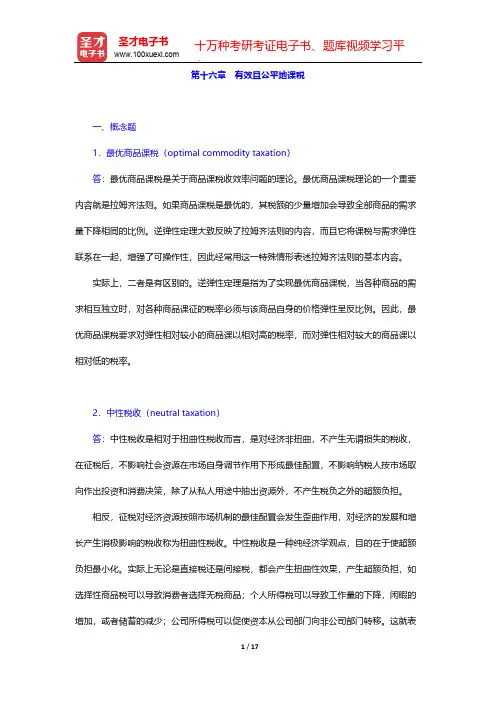
第十六章 有效且公平地课税一、概念题1.最优商品课税(optimal commodity taxation)答:最优商品课税是关于商品课税收效率问题的理论。
最优商品课税理论的一个重要内容就是拉姆齐法则。
如果商品课税是最优的,其税额的少量增加会导致全部商品的需求量下降相同的比例。
逆弹性定理大致反映了拉姆齐法则的内容,而且它将课税与需求弹性联系在一起,增强了可操作性,因此经常用这一特殊情形表述拉姆齐法则的基本内容。
实际上,二者是有区别的。
逆弹性定理是指为了实现最优商品课税,当各种商品的需求相互独立时,对各种商品课征的税率必须与该商品自身的价格弹性呈反比例。
因此,最优商品课税要求对弹性相对较小的商品课以相对高的税率,而对弹性相对较大的商品课以相对低的税率。
2.中性税收(neutral taxation)答:中性税收是相对于扭曲性税收而言,是对经济非扭曲,不产生无谓损失的税收,在征税后,不影响社会资源在市场自身调节作用下形成最佳配置,不影响纳税人按市场取向作出投资和消费决策,除了从私人用途中抽出资源外,不产生税负之外的超额负担。
相反,征税对经济资源按照市场机制的最佳配置会发生歪曲作用,对经济的发展和增长产生消极影响的税收称为扭曲性税收。
中性税收是一种纯经济学观点,目的在于使超额负担最小化。
实际上无论是直接税还是间接税,都会产生扭曲性效果,产生超额负担,如选择性商品税可以导致消费者选择无税商品;个人所得税可以导致工作量的下降,闲暇的增加,或者储蓄的减少;公司所得税可以促使资本从公司部门向非公司部门转移。
这就表相对而言的,不是绝对的。
3.拉姆齐法则(Ramsey rule)答:为了使总体超额负担最小化,税率的确定应当使各种商品的需求量按相同的比例下降,这一结论被称为拉姆齐法则(Ramsey rule)。
4.科利特-黑格法则(Corlett—Hague rule)答:科利特-黑格法则是西方经济学家科雷特(W.J.Corlette)和黑格(D.C.Hague)于1953年在他们合著的《互补性与税收超额负担》一文中提出的一条法则,是对拉姆齐法则的一种补充。


